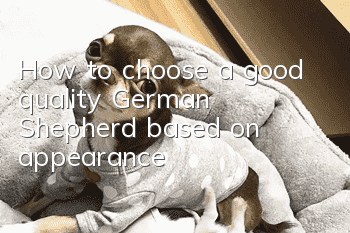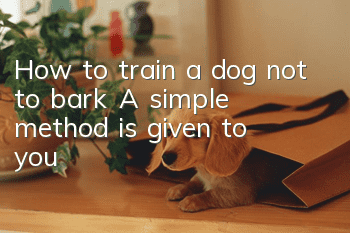How to choose a good quality German Shepherd based on appearance

German shepherds are 100% loyal to their owners. They are docile, non-aggressive, work-oriented, calm-minded, and can be used as guard dogs. However, a well-trained German shepherd is very loyal to its owner. Sometimes, police dogs in the army execute Task, it knows that it may lose its life, but it will still obey the owner's instructions to complete the task! So how do we choose an excellent German Shepherd?
German Shepherd
German Shepherd Head
The size of the German Shepherd's head should be consistent with the size of the body. The most suitable length is about 40% of the body height (the length from the forehead to the nose). The skull must feel solid. It should not be too thin and stretched. The overall feeling needs to be full. There is appropriate width between ears.
① Forehead: Viewed from the front and side, there should be no arc as a whole and no depression in the middle, making it relatively compact.
② Cheek: The cheek and jaw can show the strength of the bite force. Although the curve of the cheek is long, it must not protrude to the front.
③ Upper forehead (accounting for about 50% of the total length of the head): Looking from the ears to the front of the nose, it gradually becomes thinner at first and then becomes layered at the forehead. When viewed from above, it also extends to the wedge-shaped and long nasal surface. The width of the forehead should approximately match the length of the forehead.
④ Upper jaw and lower jaw: They must be strong and full, the bite must be strong, the lips should be tight, and connected by good muscles.
⑤ Bridge of the nose: The straight bridge of the nose should be in line with the extension line of the forehead.
⑥ Teeth: The dog’s teeth must be healthy, strong and complete. There are 42 teeth in total, 20 in the upper jaw and 22 in the lower jaw. The teeth of a German Shepherd dog bite like a scissors. It is a fault that the teeth on the upper jaw are too protruding forward or recessed. Excessive gap between teeth is also a shortcoming. There should be no gap between the incisors and the bite should be very tight. Must be strong and powerful.
⑦ Ears: medium in size, broad at the base, high and upright, both ears facing the same direction, not leaning to one side, the front end of the outer ear hub must be thin and pointed toward the front. It is not good for a dog’s ears to be slanted, short, or droopy.
⑧ Eyes: The eyes should be medium in size, apricot-shaped, not protruding, and dark in color, matching the coat color, preferably dark with black.
⑨ Neck: The neck must be strong, with well-developed muscles, and the skin of the throat must not be loose or droopy. The German Shepherd's neck should maintain an angle of 45 degrees when standing in tension, but the neck should be stretched forward when running. better.
German Shepherd Body
①The length of the German Shepherd's body should be longer than the length of the body height. The length of the body height is 100. For this length, the length of the body length should be between 110% and 117% of the body height.
② Chest depth: The depth of the chest should be about 45% to 48% of the body height. Extremely deep ones are not very good.
③ Ribs: The bones of the ribs must be fully developed, long, and in good shape. Barrel-shaped or flat are not good.
④ Elbow: The position of the elbow should extend to the sternum of the elbow. That is, the elbow is aligned with the lower line of the sternum. A normal chest allows the elbows to move easily and freely while running. If the chest is underdeveloped due to ribs, the muscles are not stretched enough, and if the chest is too round like a barrel, it will cause morbidity in the elbows and the inability to turn easily. A chest that is too flat will cause your elbows to be pushed in. The chest stretches back, resulting in a shorter waist.
⑤ Abdomen: The curve of the abdomen gradually becomes gentle and rises backward.
German Shepherd Back
① Back: including waist. Stretchy and powerfully developed. The distance between the neck and the buttocks should not be too long.
② The front part of the back must be of sufficient length and height, which is obvious relative to the entire back of the German Shepherd Dog, without interrupting the topline, and gradually extending along the topline from front to back.
③ The waist must be broad and the muscles must be developed and strong.
④ The buttocks of the female German Shepherd dog affect the formation of the placenta, so short sloping buttocks or straight rump are not ideal.
⑤ The hips are long and only slightly sloping down (about 23 degrees).
⑥ Tail: The tail should be plump with hair, curved outward and drooping like a knife. When resting, it maintains a gentle arc-shaped droop, but when excited or exercising, it becomes obviously arch-like and slightly lifted upwards. However, it must not be raised above the horizontal line, and the tail should not be straightened or rolled up on the back. Artificially shortening or changing the tail's shape is not allowed by the rules.
German Shepherd’s forelimbs and hind limbs
① Forelimbs: The shoulder blades are long and in an inclined position in contact with the ground. The upper carpus and forearm are approximately at right angles.
② The upper wrist, like the shoulder, requires strength and well-developed muscles.
③ Forearm: When viewed from any direction, it should be straight. The bones of the upper and fore wrists are oblong.
④ Do not allow the elbow to be too loose or too squeezed.
⑤ The bones of the forelimbs are long, longer than the deep tip of the chest, and account for about 55% of the height relative to the body.
German Shepherd hind limbs
① The upper part of the hind limbs must have strong muscles and a wide range.
② The upper part of the hind limbs: when viewed from the side, it is inclined.
③ The lower part of the hind limbs is slightly longer than the upper part, and the angle is about the same as the angle of the upper wrist of the forelimbs. An angle that is too deep is not good.
④ The joints must be strong. The front tarsus must also be strong and form a tight joint with the lower part of the hind limbs. The hind limbs can easily push the body forward during the dog's movements. This not only requires the dog to have strong legs, but also requires the dog to have well-developed hind limb muscles.
German Shepherd Toes
The toes of the German Shepherd Dog are short, very close, and resemble an arc-shaped bulge. The bulbous part of the sole of the foot is very thick and has no cracks. The claws are short, strong and black. The claws of a German Shepherd are usually longer than the hind feet and should be clipped on the first day of life.
German Shepherd Coat Color
The color of the German Shepherd's coat can be divided into light gray, black, brown, and yellow. Only black is mixed with other coat colors to form the main coat color tone of the dog. Small white spots on the chest or inside, or very light colors are allowed, but are not ideal for the overall appearance of the dog.
The main color of German Shepherd dogs, in addition to black, is often gray. The color of a puppy's coat can only be determined when the body is fully grown.
German Shepherd Hair
The thicker the hair on the upper part of the German Shepherd Dog, the better. Each hair must be straight and thick. The inside of the ears, the front of the head and feet, and the tips of the feet and toes are all short hair. The neck is slightly longer, the hair on the elbows of the forefoot and the root joint of the forefoot are all long, the hair on the upper part of the hind limbs and buttocks is longer, and the length of the hair is mixed. It varies depending on the dog.
- What to do if your dog is overly excited
- How do dogs stay warm in winter?
- How many months can a puppy be bred?
- How should I feed my dog as he gets older?
- Dog vomits yellow water with foam
- How to feed a newborn puppy
- Symptoms of indigestion in dogs
- What does it mean when a dog’s ears droop down?
- How to get an Alaskan to return to the kennel? Training the Alaskan!
- How to train a Scottish Terrier



